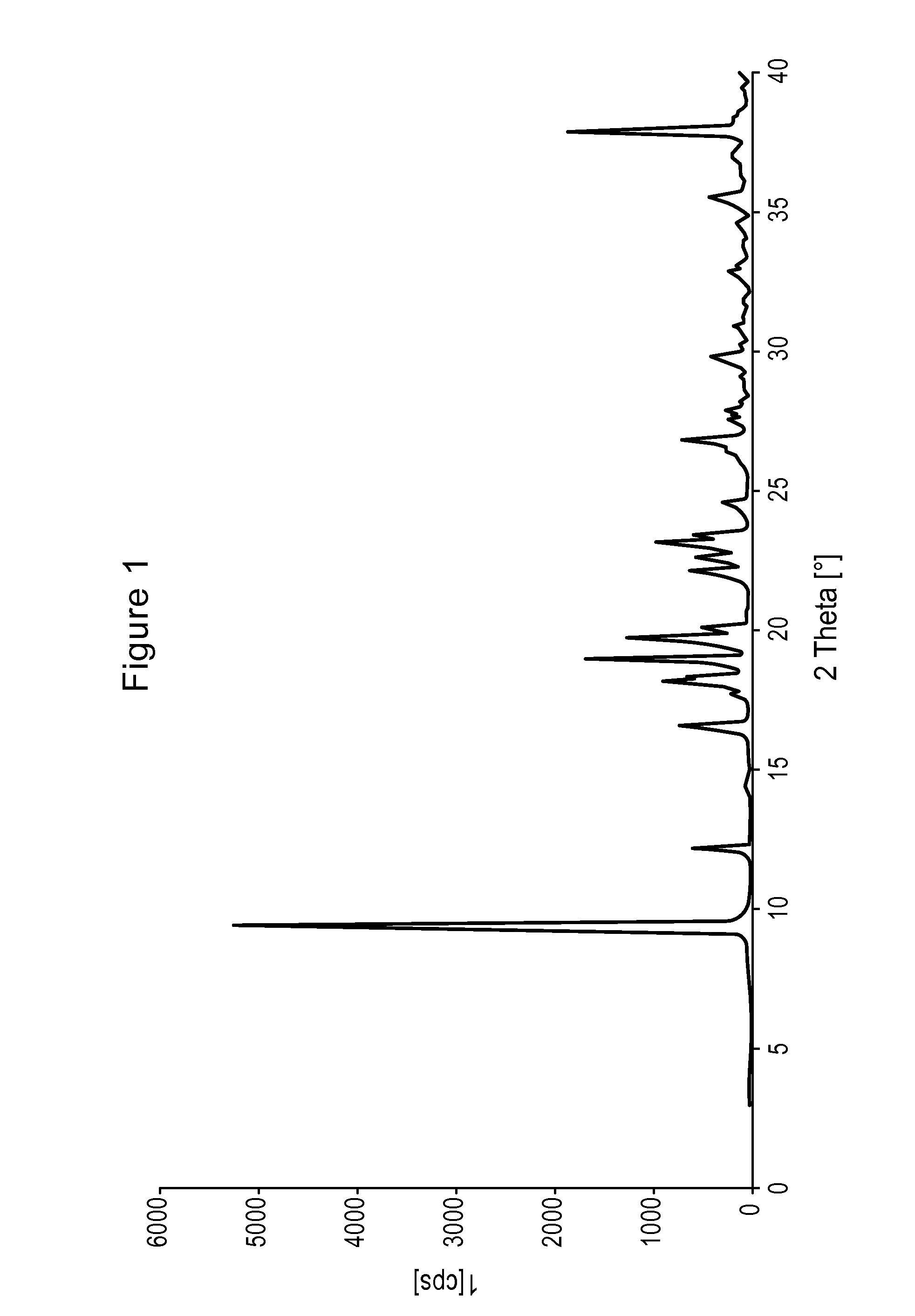Process for the synthesis of pregabalin
- Summary
- Abstract
- Description
- Claims
- Application Information
AI Technical Summary
Problems solved by technology
Method used
Image
Examples
example 1
Synthesis of the 3-(isopropoxycarbonylamino-methyl)-5-methyl-hexanoic acid (V; R=isopropyl)
[0042]A 1000 ml three-necked round-bottom flask, under nitrogen atmosphere, is added with isopropanol (272 ml), then with zinc chloride (18.1 g, 133 mmoles) and sodium azide (19 g, 293 mmoles). The suspension is stirred at room temperature for 30-40 minutes, then it is brought to 75° C. and 3-isobutyl-glutaric anhydride (45.3 g, 266 mmoles) is dropped therein in about one hour (45.3 g, 266 mmoles), always maintaining the temperature at about 75-80° C. After the adding, the mixture is stirred at such temperature for other 1-2 hours. H2O (136 ml) and NaNO2 (20.2 g, 293 mmoles) are added, and the mixture is cooled to about −5° C. and, maintaining the temperature lower than 10° C., 37% hydrochloric acid (63 g, 638 mmoles) is dropped therein. At this stage toluene (45 ml) is added, the phases are separated and the aqueous one is extracted with other toluene (20 ml). The organic phases are collected...
example 2
Preparation of the (S)-3-(isopropoxycarbonyl-aminomethyl)-5-methyl-hexanoic acid (VI; R1=isopropyl)
[0044]A 500 ml three-necked round-bottom flask, under nitrogen atmosphere, is added with raceme 3-(isopropoxycarbonyl-amino-methyl)-5-methyl-hexanoic acid (44.2 g, 0.180 moles), triethylamine (8.20 g, 0.081 moles) and (S)-(−)-phenyl-ethylamine (12.00 g; 0.099 moles) in a 95:5 water / isopropanol mixture (200 ml) heated at 55-60° C. The mixture is spontaneously left to cool to room temperature, then it is cooled to 0-5° C. for at least 1 h. The solid is filtered off and washed with cool water (2×20 ml) and then with cool toluene (4×20 ml), it is dried in oven at 55-60° C. for 16-18 h. 27.0 g of white solid are obtained with an enantiomer ratio of 99:1.
[0045]1H-NMR (300 MHz, CDCl3, 28° C.): δ 7.4-7.1 (m, 5H); 4.7 (m, 1H); 4.0 (q, 1H); 3.0 (dd, 1H); 2.8 (dd, 1H); 2.1 (m, 1H); 1.9 (m, 2H); 1.6 (m, 1H); 1.3 (d, 3H), 1.1 (d, 6H); 1.0 (m, 2H); 0.8 (dd, 6H).
example 3
Synthesis of the (S)-(+)-3-aminomethyl-5-methylhexanoic acid (I)
[0046]A 500 ml three-necked round-bottom flask, under nitrogen atmosphere, is added with (S)-3-(isopropoxycarbonyl-amino-methyl)-5-methyl-hexanoic acid salt of (S)-(−)-phenyl-ethyl-amine (70.0 g, 0.190 moles), 35% hydrochloric acid (29.7 g, 0.285 moles), water (200 ml) and toluene (100 ml) and the mixture is vigorously stirred for 10-15 minutes. The phases are separated and the aqueous phase is extracted with toluene (2×100 ml). The collected organic phases are concentrated to small volume to obtain an oil which is added with 30% hydrochloric acid (57.8 g, 0.475 moles). The mixture is heated at 90° C. for 24-48 h. At end-reaction 41% aqueous monomethylamine (26.7 ml) is added till pH of about 6 and left to cool to room temperature. The mixture is cooled to 0-5° C. for at least 1 h and then the solid is filtered off and washed with a 1:1 water / isopropanol mixture cooled to 0-5° C. (3×15 ml). The solid is dried in oven at...
PUM
| Property | Measurement | Unit |
|---|---|---|
| Dimensionless property | aaaaa | aaaaa |
| Dimensionless property | aaaaa | aaaaa |
| Dimensionless property | aaaaa | aaaaa |
Abstract
Description
Claims
Application Information
 Login to View More
Login to View More - R&D
- Intellectual Property
- Life Sciences
- Materials
- Tech Scout
- Unparalleled Data Quality
- Higher Quality Content
- 60% Fewer Hallucinations
Browse by: Latest US Patents, China's latest patents, Technical Efficacy Thesaurus, Application Domain, Technology Topic, Popular Technical Reports.
© 2025 PatSnap. All rights reserved.Legal|Privacy policy|Modern Slavery Act Transparency Statement|Sitemap|About US| Contact US: help@patsnap.com



